In Remembrance of Sondre Nordheim
Sondre died in North Dakota in 1897, but he is not forgotten. As a testimonial to his memory, the ski legend from Telemark has been honoured with many different tributes, both in Norway and the United States.
Sondre’s memory is definitely kept alive both at the place where he was born and where he is buried.
There are also several books, articles and TV specials done about Sondre. He is presented at different ski museums and his name mentioned on hundreds of web sites.
In Morgedal the Year Sondre Died
After the announcement of Sondre’s death in 1897, Morgedal residents held a memorial ceremony with a speech by Gunnar Mandt, a teacher and ski enthusiast from Vrådal in Telemark.
In his memorial speech Mandt said, “Now that we know the sport of skiing is “a joyous sign of the times”, a force that unites all parts of the country, nations, peoples and parties in peaceable competition, we must acknowledge Sondre’s unique achievement. The ways of Our Lord are strange. Just when doubt and evil omens were about to wreak havoc with our times, a shabby guy from Morgedal came along and helped to create a new climate of optimism.”
Honoured by a Friend
At a ceremony June 10, 1925, 100 years after Sondre’s birth, a memorial stone was erected in the centre of Morgedal.

Aslak Bergland as a young student
Photo from the book "Ski og Sudpol"
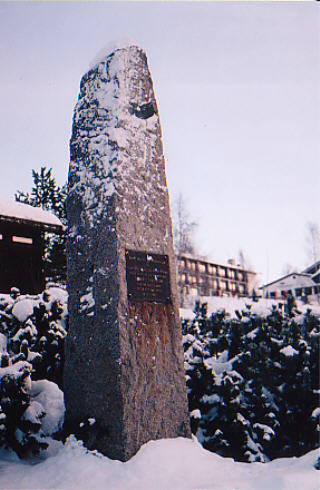
The four meter tall stone was funded by the Morgedal Sports Club along with the Association for the Promotion of Skiing in Oslo. Its plaque was a gift from chamberlain Diderik Cappelen, owner of the Ulefos Jernværk (Ulefos Foundry), in Telemark.
Photo by Eivind Molde
Speeches were presented by Finn Qvale, chairman of the Ski Association and Morgedal resident, clergyman Aslak Bergland, a poet and 20-year friend of Sondre.
In his speech, Mr. Bergland said, “Sondre was a jack of all trades, but there was one area where he was truly an artist, yes, in fact virtuous – skiing. He was a skier all his life, and no one could ever compare to him.”
“I remember folk talked about a jump Sondre did when he was a child. He had placed a ladder on their house and covered it with spruce sprigs and snow. He set off and on the rooftop his jump was so high that he flew over the cowshed as well! He didn’t fall of course, and he continued all the way down to Bjaaland. There a cow was standing out in the yard. Sondre came dashing like greased lightning, and suddenly the cow tipped over! Sondre said it was because of the air pressure, but personally I think the cow was startled!”
“We would have been surprised if Sondre fell on the slopes. And I never saw it either. I sometimes saw him touch the ground with one hand or both, to keep his balance, but he never fell. Never.”
“He had this upright carriage, was very resilient and his body seemingly only consisted of muscles and tendons. Besides, he had this special charisma. His face was characteristic, a bit pale, with strong features and a very beautiful smile. His eyes had this special look, particularly when he was on the slopes with others. I was just a kid at that time, but I watched him so often, and I couldn’t quite figure out what that look was. When I think back, I will use the words “mastery” and “superiority”.”
“He really radiated a characteristic class of his own”, Mr. Bergland said in his speech.
In 1887 Aslak Bergland also had published a book of poems complimenting Sondre. The book was called “Lauvduskar” (“Garland of Leaves”).
One of his poems reads:
Behold him on the highest peak
Adjusting skis and bindings
With cap in hand he stands erect
Then plunges boldly down
You saw him race from steep to steep
With snowdust in his wake
Now in the air, now on the ground
Headlong down the hill
He leapt aloft from off the roof
And floated o’er the barn
Far down the hill he landed then
And stopped at Bjaaland’s farm
It was his first great skiing feat
The run he made that day
And later there were none who dared
To follow in his tracks
He leapt aloft from off the roof
And floated o’er the barn
Far down the hill he landed then
And stopped at Bjaaland’s farm
It was his first great skiing feat
The run he made that day
And later there were none who dared
To follow in his tracks
Finding an Unmarked Grave
March 9, 1897 Sondre passed away while living on the North Dakota prairie. The burial was delayed until 1898, probably because of the hard winter. He was buried in an unmarked grave eight kilometres from his farm. Sondre had not told his neighbours and friends about his skiing fame, and because the grave was unmarked, no one knew where the legendary skier was buried. Dorothy Lyon of Atlanta, Georgia, a great grandchild of Sondre, happened to find that her great grandfather’s skiing feats were recognized in the Encyclopedia Britannica. Volume 20 of the 1955 edition refers to him as “a pioneer not only in the slalom and jumping, but also in makings skis”. The Britannica describes Sondre’s impact on the development of skiing, the skiing environment in Morgedal, Sondre’s performance in the important Christiania (Oslo) skiing competition in 1868, and the turning techniques and his equipment. It also reports that “the Telemark and the Christiana styles were adopted by other Norwegian skiers and spread rapidly to the Alpine countries”.
Dorothy decided to initiate a search for the location of his grave. Growing up in Grand Forks, North Dakota together with her grandfather Åmund (Sondre’s son), Dorothy felt a strong connection which made her determined to find out exactly where her great grandfather was buried.
In the summer of 1965 she contacted the Judge of McHenry County, which was the county where Sondre had lived. They advised her to get in touch with the churches in that area. So on July 6, 1965 she wrote a letter to the oldest church in the Mouse River loop, Norway Lutheran. Later the same month the location of Sondre’s grave was pointed out based on a check of the burial records of the church, done by Vera Nelson, secretary of the congregation, along with information from early residents.
Sondre’s unmarked grave was identified in the southeast corner of Norway Lutheran Church Cemetery south of Denbigh. Rev. Richard T. Wanberg of Towner, pastor of the Norway Lutheran since 1919, was instrumental in locating the grave. According to the cemetery records, two grandchildren of Sondre are buried in the same cemetery. Neither of their graves is marked.
Denbigh is a small town about one hour’s drive from Minot, midway between Minot and Rugby, which is known as the geographical centre of North America. On June 12, 1966, a stone with a memorial plaque was unveiled at his grave, organized by committees from Norway Lutheran Church and North Dakota State Historical Society. The plaque was made without charge by Ulefos Jernværk (Ulefos Foundry), located at Ulefoss, Telemark. The boulder was transported from the Bismarck area by the National Guard. Norwegian organizers included Eivind Strondi from the Morgedal Sports Club and Jakob Vaage, Norwegian ski historian and curator of the Ski Museum in Holmenkollen, Oslo.
Witnessed by hundreds of people, two young women from the Norway Lutheran Congregation, Sandra Espeseth and Carolyn Moen, both dressed in Norwegian national costumes, unveiled the plaque on the boulder, by removing a Norwegian flag.
Speakers at the ceremony were Vaage and Edward A. Milligan, President of the State Historical Society. When speaking inside the overcrowded church, Vaage described Sondre as “the fastest man in the world at the time”. Vaage summarized Sondre’s contribution to skiing, and said, “We thank him for his work, which was never rewarded when he lived. I feel honoured to be able to pay tribute to Sondre Norheim today.”
A few days later the Senate of the United States learned about the dedication of the Sondre plaque. These are the remarks by Hon. Quentin N. Burdick of North Dakota, according to the Congressional Record for June 15, 1966, “Mr. President, Sunday an iron plaque made in Norway was dedicated at the Norway Lutheran Cemetery near Denbigh, N. Dak. It marks the grave of an internationally famous Norwegian sportsman, Sondre Norheim, who after revolutionizing the world of skiing in the 19th century, immigrated to the United States and North Dakota from his native Norway.”
“A recent editorial of the Minot Daily News of North Dakota tells a bit of this story and conveys the pride with which North Dakotans appreciate their association with the famous sports figure. I ask unanimous consent that the editorial be printed in the Appendix of the Record. There being no objection, the editorial was ordered to be printed in the Record.” In the editorial, Minot Daily News describes Sondre as “a modest man, who did not tell his neighbors at Denbigh of his prowess as a ski jumper. The neighbors knew him as a quiet man with pride of workmanship with wood”. “It is quite possible that Norheim himself had no inkling of the importance of his contribution to competitive skiing. Now his name is prominent in all histories of the sport.”
“Without much expense to anyone, people on both sides of the Atlantic and in the mid-continent of America have joined to put a memorial on the grave of a man who richly deserved to be remembered”, the News said in its editorial.

Two of Sondre's great granddaughters, DeLoris Saunderson Raustadt (left) and
Dorothy Lyon at his grave
Photo by Anne-Gry Blikom
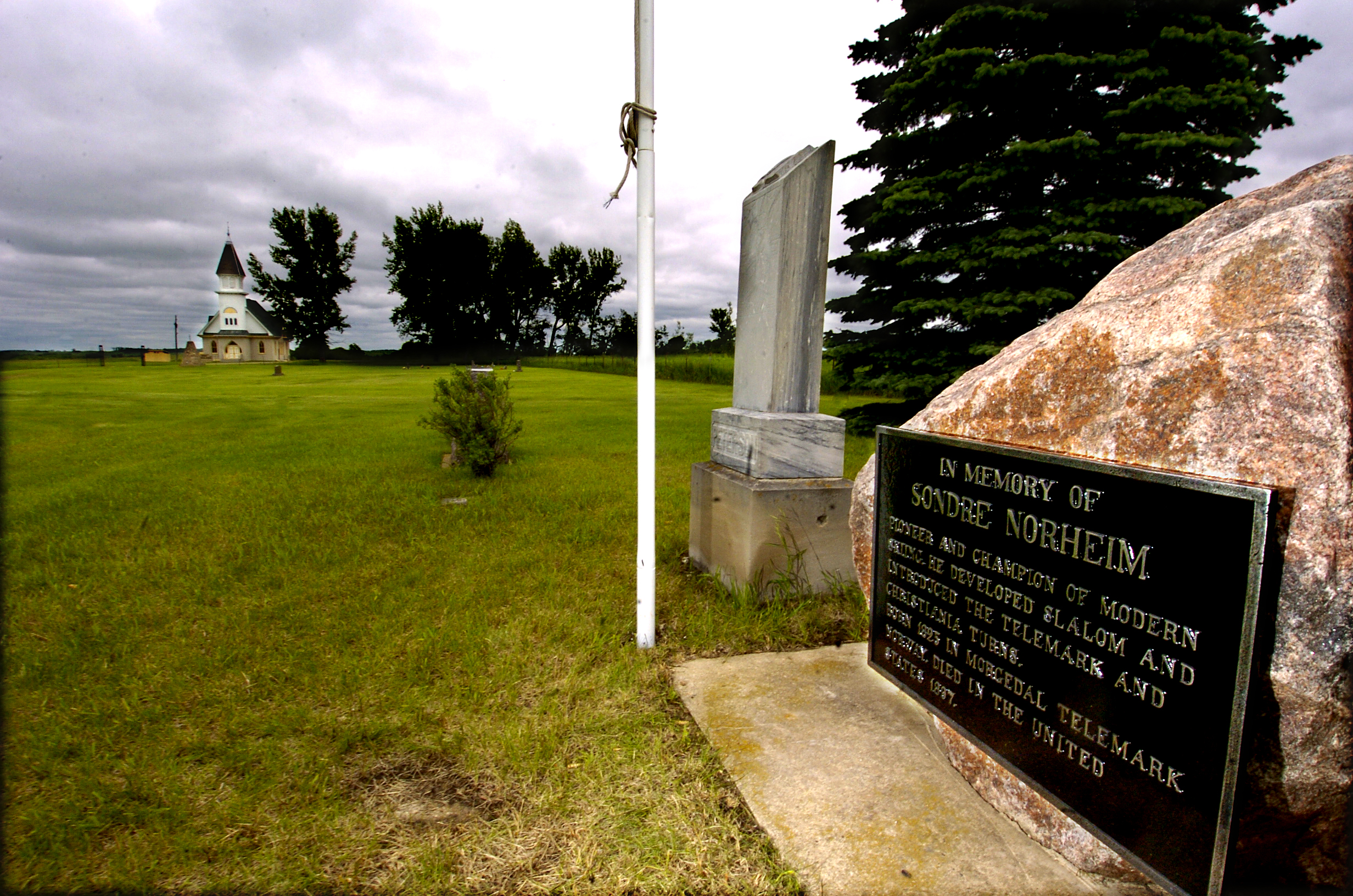
Norway Lutheran Church Cemetery with Sondre's grave to the right
Photo by Fredrik Pedersen
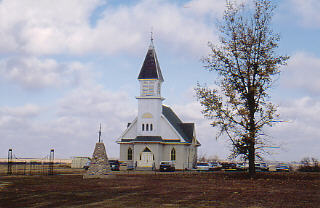
Norway Lutheran Church was built in 1907
by early Norwegian settlers
Photo by Eivind Molde
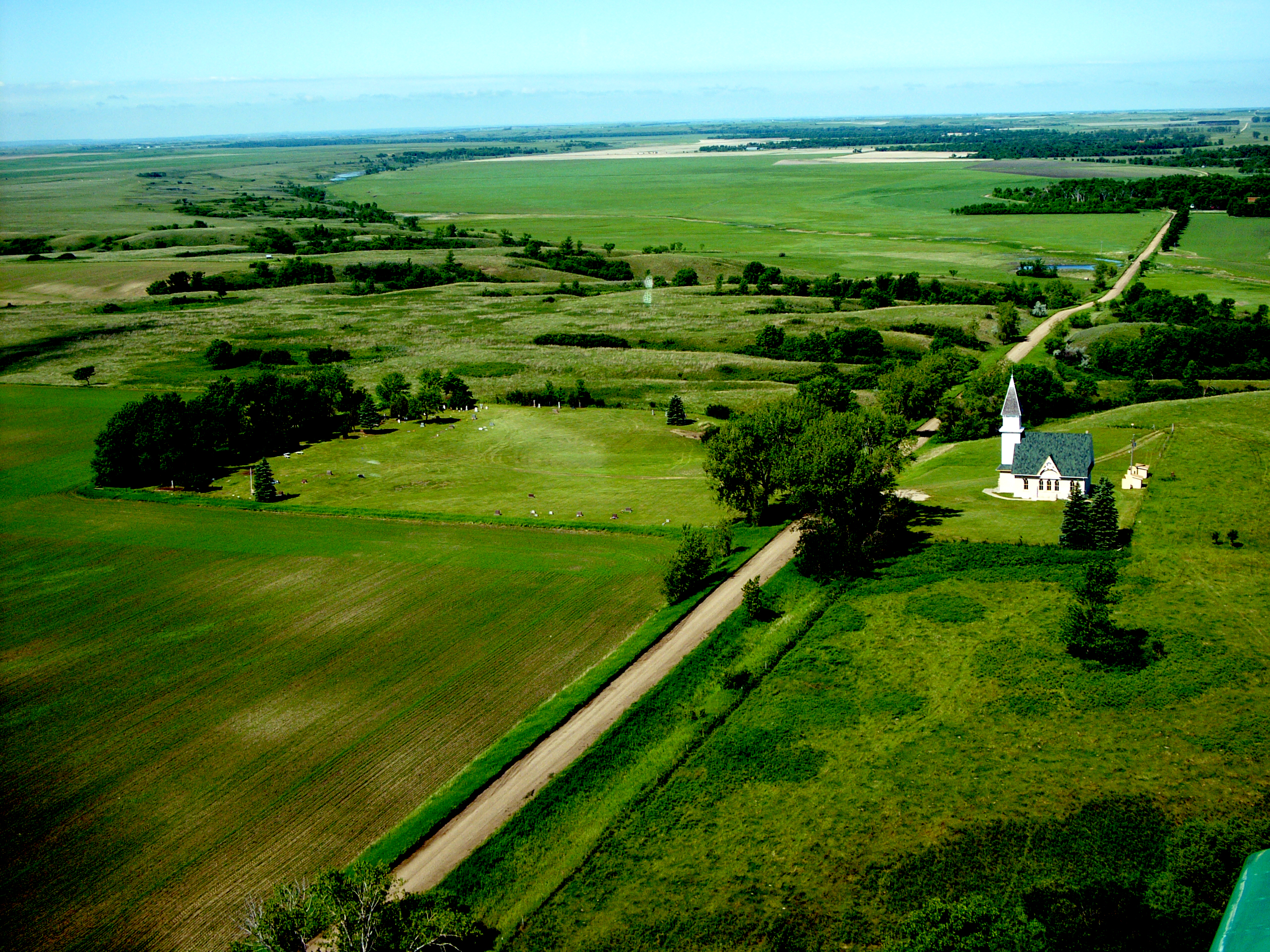
Norway Lutheran Church and Cemetery south of Denbigh,North Dakota
Photo by Fredrik Pedersen
Sondre Statues in Norway and the United States
There are two statues of Sondre. One is located in Minot, North Dakota, the other in Morgedal. The 2.5-meter tall identical bronze statues were sculpted by renowned artist Knut Skinnarland (1909-1993) of Rauland, Telemark, and were unveiled in 1987 and 1988.
The project was a joint effort between the Norsk Høstfest Association in Minot and the Friends of Minot Club in Skien, Telemark. Minot is located in the state to which Sondre immigrated, and he is buried near Denbigh, about one hour’s drive from Minot. As a cultural festival focusing on the strong bonds of heritage between Norway and the Midwest, Norsk Høstfest had a strong belief in the statue project.
On the Norwegian side, this project became a major goal for the Friends of Minot Club, a club dedicated to strengthening the bonds between North Dakota and Telemark. Skien and Minot are also sister cities.
During a visit to Morgedal in 1980, Høstfest President Chester Reiten told Ragnhild Hagen, who is in charge of the Friends of Minot Club, that he had plans for statues of Sondre in Minot and Morgedal. Four years later Hagen and Reiten decided to go ahead with the statue project.
Committees were established on both sides of the Atlantic. Reiten chaired the fund raising efforts in Dakota, with Dale Mattern and Ken Kitzman co-chairing the committee for installation and the unveiling ceremony. The Norwegian committee was chaired by Ragnhild Hagen. Several organizations and companies contributed in the fundraising, with costs split equally between Minot and Telemark.
Plans had also been made earlier for a Sondre statue. The idea came from Edward A. Milligan, a former president of the North Dakota State Historical Society. Still president of the society, Mr. Milligan was a key player when the memorial plaque was dedicated at Sondre’s grave near Denbigh in 1966.
Milligan later contacted Knut Skinnarland with regard to obtaining duplicate statues of Sondre. His principal Norwegian associate on this project was Jacob Vaage at the Ski Museum in Holmenkollen, Oslo.
In 1977 Knut Skinnarland had a plaster figure ready, but unfortunately Mr. Milligan passed away, and the project was not completed.
But it was the 1977 draft, however, which was the basis for the monument when the statues became a reality 10 years later, thanks to the Friends of Minot Club and Norsk Høstfest.

Ragnhild Hagen and Chester Reiten with the "Little Sondre" sculpture, which was given to the town of Minot from the Friends of Minot Club in 1993
Photo by Eivind Molde
The Statue in Minot
Located in the Scandinavian Heritage Park, the Minot statue of Sondre was unveiled on October 16, 1987.
Remarks were given by President of the Norsk Høstfest Association, Chester Reiten, Minot Mayor George Christensen, Skien Mayor Einfrid Halvorsen, President of the Friends of Minot Club, Ragnhild Hagen, President of the Telemark Fylkes Handelsstevne, Kjell Strand and grandnephew of Sondre, Eivind Strondi of Morgedal.
The Scandinavian Heritage Park is a testimonial to the strong bonds between Scandinavia and the Midwest. More than 800,000 Norwegians immigrated to America in 1825-1939 and most of them settled in the states up north. Actually close to half the population of Minot has Scandinavian ancestors.
The park includes an old storehouse from Norway, a replica of the Norwegian Gol Stave Church, a Danish windmill, statues of Icelandic explorer Leiv Eriksson and Norwegian-born ski jumper Casper Oimoen, an information centre and more. In 1993 the Sondre Norheim Eternal Flame Monument was added to the park.
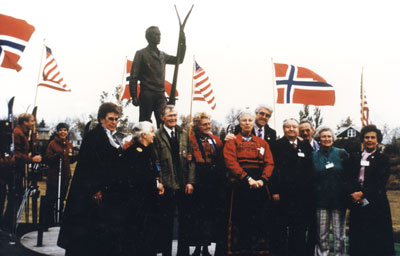
Norwegian guests: Einfrid Halvorsen (left), Tove and Knut Skinnarland, Ragnhild Hagen, Inger and Olav Skoe, Kjell Strand
Courtesy of Norsk Høstfest Assn.
The Statue in Morgedal
With 20 ski veterans as guard of honour, the Sondre statue was unveiled in the centre of Morgedal by HM King Olav on January 16, 1988. About 2,000 people attended the ceremony on a beautiful winter day.
Eivind Strondi was the master of ceremonies, and among the guests were official representatives from North Dakota, Canada and Telemark. The organizing committees were represented by Chester Reiten and Ragnhild Hagen. Chairman of the Morgedal Sports Club, Asbjørn Gåsdalen, thanked the committees for all their efforts in making this project a reality.
“Sondre was a true pioneer. He generated enthusiasm and excitement far beyond Morgedal”, the King said in his speech. “Sondre brought something new to the nation and the world. With his example he generated opportunities. He has made Norwegian words like ski and slalom known worldwide.
He fully deserves to be celebrated like we do today”, the King said.
During the ceremony a message and greeting was sent from Morgedal to the Olympic Games in Calgary, due to be held in February the same year. The text of the message was read in front of the King by 17-year-old Sondre Versto of Morgedal.
The message brought friendly wishes that young people should live out the joy of skiing that Sondre had, in peaceful competition, first of all to participate, not to win. Norwegian ski star and giant slalom gold winner from the 1952 Winter Olympics in Oslo, Stein Eriksen, read the same text as he later introduced the message at the Olympic stadium in Calgary.
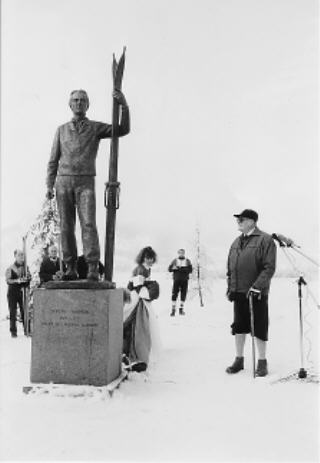
The Sondre statue is unveiled by HM King Olav
Photo by Tore Øyvind Moen, Varden
Knut Skinnarland – the Sondre Sculptor
A brilliant artist, an impassioned and warm person. This is how the sculptor Knut Skinnarland (1909–1993), the creator of the Sondre statue, is described by friends, colleagues and people who had the good fortune to know him.
Knut Skinnarland was born in Rauland, Telemark January 15, 1909. He came from a family of craftsmen and artists. The internationally known author Tarjei Vesaas was one of his close relatives and best friends.
After several years with studies at academies in Norway, he studied abroad at the academy in Copenhagen and also at the Académie Colarossi in Paris.
While at the Copenhagen academy, Knut met Danish Tove, who later said, “The very first time I met Knut, I knew he was the finest man I’d ever met.”
Tove and Knut married and had two children. The family wintered in Oslo and spent summers at their adventurous property in Rauland.
“Art is patience and willpower”, Knut said. “It’s about the ability not to give up and being open for impressions all your life. It has nothing to do with hurry, it is more like a kind of growth, like a tree, you might not reap before you are 80.”
Knut participated along with other artists in a 17 year restoration of the famous Nidarosdomen Cathedral in Trondheim. During the 50’s and 60’s he made about 30 sculptures at this majestic cathedral. For this work he received “Nidarosdomen Gold Medal”.
“Knut Skinnarland’s portrayal art is some of the finest made in this country”, a colleague said. His artwork can be seen in all parts of the country. Among his many sculptures are the monument over the author and fellow villager Aasmund Olavsson Vinje.
In 1988 he was awarded The Kings Decoration, given for meritorious services for his contribution to Norwegian culture, and the Cultural Award from the municipality of Vinje. Knut Skinnarland has also received the Cultural Award from the county of Telemark.
His friends describe him as a hard working artist, professional, serious and modest. Norwegian chairwoman for the Sondre Norheim Statue committee, Ragnhild Hagen describes, “Knut enriched the lives of his many Norwegian and American friends with fond memories. He also loved lyrics, literature and enjoyed folk music. Though he was quiet and soft spoken, what he said was always honest and well thought through. He made enormous demands on himself as an artist.”
Knut was the clear choice when the creation of a statue of Sondre was planned. As a matter of fact, Knut had already been thinking of just such a statue – in 1977 he had a plaster figure ready which became the basis for the monument. The draft was made on the initiative of a former president of the North Dakota State Historical Society, Edward A. Milligan, who originated the idea for a Sondre statue.
“I wondered what kind of impression I should give the statue of Sondre”, Knut said. “Should I make him steeping down the hills, or should it be an abstract monument maybe? All I had to refer to was all the stories about Sondre and a picture of him at age 59, taking in America.”
Finally Knut decided to make Sondre monumental standing with his skis by his side. That’s the way it had to be.
In 1987 this monument was finished and on October 16 it was dedicated in Minot, North Dakota. Exactly three months later an identical statue was unveiled in Morgedal by HM King Olav.
The Norwegian Broadcasting Corporation (NRK) produced a three-part TV series about the creation of the Sondre statue. Directed by Johan Vestly, the TV team followed Knut during his work at his atelier in Rauland and also when the statue in Minot was dedicated.
Some years later Knut Skinnarland created another Sondre sculpture - the much smaller "Upptrekkjaren" ("The drawn-up style jumper") or "Vesle Sondre" ("Little Sondre"). The scultpture depicts Sondre in a spectacular jump, using the typical Sondre "drawn-up" style.
This sculpture of Sondre was one of Knut Skinnarland’s last works.
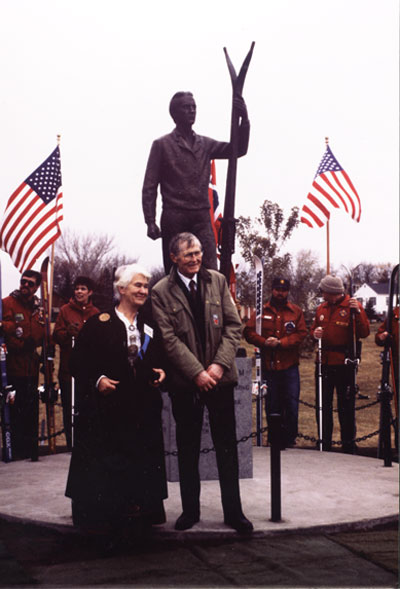
Tove and Knut during the unveiling of the Sondre statue in Minot, North Dakota
Courtesy of Norsk Høstfest Assn.
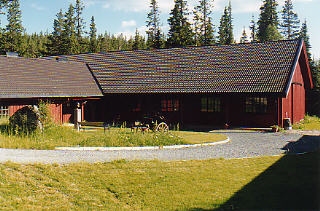
Artworks of this highly recognized Telemark artist can be seen at the Knut Skinnarland Collection in Rauland. The collection includes more than 100 copies of Skinnarland’s sculptures and also a copy of his studio.
Photo by Eivind Molde
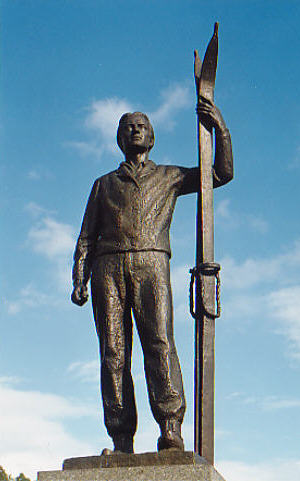
The Sondre statue
Photo by Eivind Molde
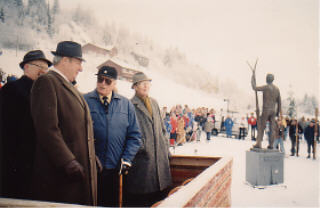
From the dedication ceremony in Morgedal, Knut Skinnarland is on the right. At his side are HM King Olav and Norsk Høstfest President Chester Reiten.
Courtesy of Ragnhild Hagen
Honouring Sondre at His Grave Site
In 1983, Princess Astrid of Norway visited Sondre’s grave south of Denbigh. The Princess was special guest at the Norsk Høstfest (Norwegian Fall Festival) in Minot that year.
Since 1991, Norsk Høstfest Association has been honouring the memory of Sondre every year at the Norsk Høstfest. This is the largest Scandinavian festival in North America, and has been held in Minot every fall since 1978.
During the festival there is a wreath-laying ceremony at Sondre’s gravesite at the Norway Lutheran Church Cemetery near Denbigh, one hour’s drive from Minot. The ceremony is held under the auspices of the Scandinavian
Heritage Association. Local organizers have been the church officers Lillian and Myron Espeseth along with other members of the church.
Several guests have participated in the ceremonies over the years, such as representatives from the Norwegian Embassy, from the Church of Norway, and Norwegian mayors to name a few.
In 1992 the President and CEO of Lillehammer Olympic Organizing Committee, Gerhard Heiberg participated (the Winter Games were held at Lillehammer, Norway in 1994).
“I have the greatest respect for what Sondre Norheim has done for the sport of skiing”, Heiberg said, and continued, “Being here on the prairie where Sondre lived, is a very special experience for me. I think about what an effort and challenge it must have been for him to start all over again in a new country at his age, over 60 years old”.
Ambassador of Norway to the US, Tom Vraalsen, has attended the ceremony two times. In his speech at October 14, 1997, Vraalsen said, “Until about 1850, skiing was a means of transport in wintertime, not a sport. Sondre Norheim changed all that. With his own incredible skiing skills and his modifications of the ski equipment, Sondre Norheim laid the foundation for a new sport which became global within less than 50 years of his death. Without Sondre Norheim, no Aspen, no Vail, no Val d’Isère, no Holmenkollen. I even doubt that there would be any Olympic Winter Games, had it not been for this great man. He is the Father of Modern Skiing.”
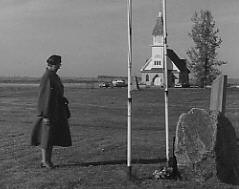
Princess Astrid at Sondre's grave
Photo by Ragnhild Hagen
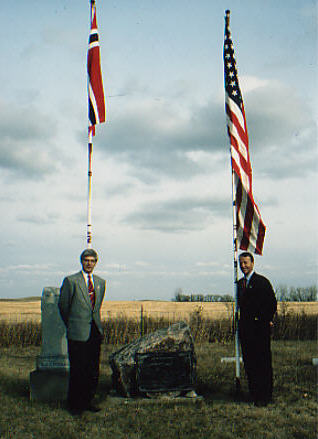
Lillehammer Mayor Audun Tron (left) and Gerhard Heiberg
Photo by Anne-Gry Blikom
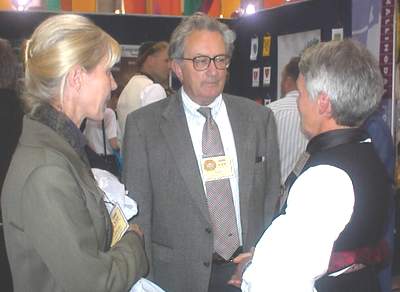
Tom Vraalsen talking to Høstfest visitors
Photo by Ole Jørn Solberg
In the hall of fame
In 1974, Sondre was inducted into the US National Ski Hall of Fame in Ishpeming, Michigan. The Hall is regarded as the most prestigious repository of the ski history of the United States.
We find about 50 that were born in Norway among the more than 300 inductees – Alf Engen, Casper Oimoen, Birger Ruud, Sigmund Ruud, Sverre Engen, John A. “Snowshoe” Thompson, Stein Eriksen, Jakob Vaage and others.
Later Sondre became a member of the Scandinavian-American Hall of Fame, which was established in 1984 by the Norsk Høstfest Association in Minot, North Dakota, “designed to honor Scandinavian-Americans who have distinguished themselves in their fields of expertise and in service to mankind”.
Sondre was named to the Scandinavian-American Hall of Fame in 1984. Among other members are Walter Mondale, Gerhard Heiberg, Knut Haukelid, Thor Heyerdahl, Stein Eriksen, Eric M. Hilton and Earle Hyman.
New members are added to the Hall of Fame during the annual Norsk Høstfest in Minot each year.
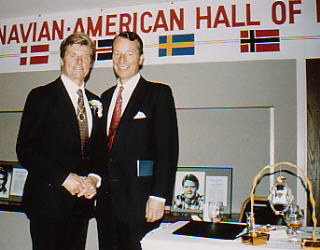
Stein Eriksen and Gerhard Heiberg
Photo by Anne-Gry Blikom
Sondre Commemorative Stamps
In 1975, Sondre was the subject of commemorative stamps marking the 150th anniversary of his birth. Stamps were made both in North Dakota and in Morgedal.
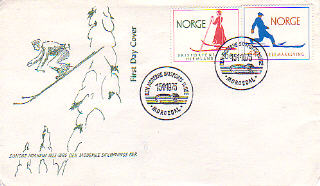
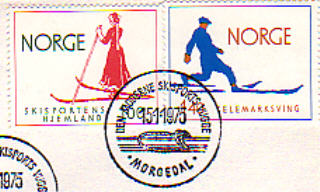
The stamps from Morgedal
Courtesy of Eivind Strondi
The first cover of the North Dakota stamps was sent from Bottineau, ND Post Office to HM King Olav of Norway, others went to members of the Royal family, the Church of Norway, the Norwegian ambassador in Washington and US President Gerald Ford. Proceeds from those covers went into the Sondre statue fund.
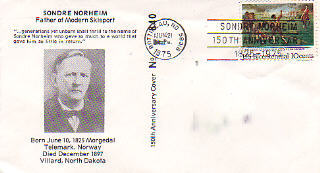
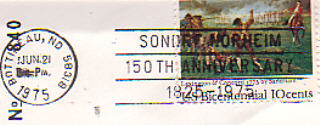
The stamps from North Dakota
Courtesy of Eivind Strondi
Sondre’s Home Village – Keeping the History of Skiing Alive
In recognition of the impact Sondre and the village of Morgedal had on sport skiing, Sondre’s birthplace Øverbø has been chosen three times as the site for lighting the Olympic Torch.
This former cotter’s farm has become a museum, visited by people from all over the world. A journey through the history of skiing can be experienced at the Norwegian Ski Museum Morgedal, in the heart of the valley.
The Morgedal Flame from 1960 is still burning in Squaw Valley. And the flame from the 1994 Winter Olympic ceremony at Øverbø is burning both in Morgedal and in the Scandinavian Heritage Park in Minot.
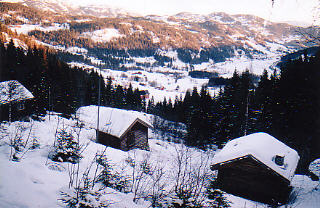
Øverbø and the valley of Morgedal
Photo by Eivind Molde
Sondre Quotes
HM King Olav of Norway, speaking during the statue dedication ceremony in Morgedal January 16, 1988,
“Sondre was a true pioneer. He generated enthusiasm and excitement far beyond Morgedal. Sondre brought something new to the nation and the world. With his example he generated opportunities. He has made Norwegian words like ski and slalom known worldwide. He fully deserves to be celebrated like we do today.”
President and CEO of Lillehammer Olympic Organizing Committee, Gerhard Heiberg, speaking in Norway Lutheran Church near Denbigh, North Dakota during a wreath-laying ceremony at Sondre’s gravesite October 1992,
“I have the greatest respect for what Sondre Norheim has done for the sport of skiing. Being here on the prairie where Sondre lived, is a very special experience for me. I think about what an effort and challenge it must have been for him to start all over again in a new country at his age, over 60 years old.”
Ambassador of Norway to the US, Tom Vraalsen, speaking in Norway Lutheran Church near Denbigh, North Dakota during a wreath-laying ceremony at Sondre’s gravesite October 14, 1997,
“Until about 1850, skiing was a means of transport in wintertime, not a sport. Sondre Norheim changed all that. With his own incredible skiing skills and his modifications of the ski equipment, Sondre Norheim laid the foundation for a new sport which became global within less than 50 years of his death. Without Sondre Norheim, no Aspen, no Vail, no Val d’Isère, no Holmenkollen. I even doubt that there would be any Olympic Winter Games, had it not been for this great man. He is the Father of Modern Skiing.”
A 1966 Minot Daily News editorial, when the Sondre grave in Norway Lutheran Church Cemetery was marked for posterity,
“…a modest man, who did not tell his neighbors at Denbigh of his prowess as a ski jumper. The neighbors knew him as a quiet man with pride of workmanship with wood. It is quite possible that Norheim himself had no inkling of the importance of his contribution to competitive skiing. Now his name is prominent in all histories of the sport. Without much expense to anyone, people on both sides of the Atlantic and in the mid-continent of America have joined to put a memorial on the grave of a man who richly deserved to be remembered.”
Aslak Bergland, priest and poet, who personally knew Sondre for 20 years, speaking at the ceremony in Morgedal 100 years after Sondre’s birth,
“Sondre was a jack of all trades, but there was one area where he was truly an artist, yes, in fact virtuous – skiing. He was a skier all his life, and no one could ever compare to him.”
“I remember folk talked about a jump Sondre did when he was a child. He had placed a ladder on their house and covered it with spruce sprigs and snow. He set off and on the rooftop his jump was so high that he flew over the cowshed as well! He didn’t fall of course, and he continued all the way down to Bjaaland. There a cow was standing out in the yard. Sondre came dashing like greased lightning, and suddenly the cow tipped over! Sondre said it was because of the air pressure, but personally I think the cow was startled!”
“We would have been surprised if Sondre fell on the slopes. And I never saw it either. I sometimes saw him touch the ground with one hand or both, to keep his balance, but he never fell. Never.”
“He had this upright carriage, was very resilient and his body seemingly only consisted of muscles and tendons. Besides, he had this special charisma. His face was characteristic, a bit pale, with strong features and a very beautiful smile. His eyes had this special look, particularly when he was on the slopes with others. I was just a kid at that time, but I watched him so often, and I couldn’t quite figure out what that look was. When I think back, I will use the words “mastery” and “superiority”.”
“He really radiated a characteristic class of his own.”
Gunnar Mandt, a teacher and ski enthusiast from Vrådal, Telemark, speaking during a memorial ceremony in Morgedal in 1897, the year Sondre died.
“Now that we know the sport of skiing is “a joyous sign of the times”, a force that unites all parts of the country, nations, peoples and parties in peaceable competition, we must acknowledge Sondre’s unique achievement. The ways of Our Lord are strange. Just when doubt and evil omens were about to wreak havoc with our times, a shabby guy from Morgedal came along and helped to create a new climate of optimism.”
Memorial Texts
The Memorial Stone in Morgedal (June 10, 1925)
DENNE STEINEN HEV MORGEDØLAR
OG
FORENINGEN TIL SKI-IDRÆTTENS FREMME
REIST TE MINNE OM SKILØYPAREN
SONDRE NORDHEIM
PAA 100 AARS DAGEN
ETTER HAN VART FØDD
10. JUNI 1825
The gravestone (June 12, 1966)
IN MEMORY OF
SONDRE NORHEIM
PIONEER AND CHAMPION OF MODERN
SKIING. HE DEVELOPED SLALOM AND
INTRODUCED THE TELEMARK AND
CHRISTIANIA TURNS.
BORN 1825 IN MORGEDAL, TELEMARK,
NORWAY. DIED IN THE UNITED STATES 1897.
The Sondre Statue in Minot (October 16, 1987)
Front,
SONDRE NORHEIM
1825 – 1897
FATHER OF MODERN SKIING
BORN:
MORGEDAL, TELEMARK,
NORWAY
DIED:
McHENRY COUNTY,
NORTH DAKOTA
Knut Skinnarland
Sculptor
Side,
DONATED BY:
SISTER CITIES OF
SKIEN, TELEMARK,
NORWAY
AND
MINOT, NORTH DAKOTA,
U.S.A.
DEDICATED
OCTOBER 16, 1987
The Sondre Statue in Morgedal (January 16, 1988)
Front,
SONDRE NORHEIM
1825 – 1897
FAR TIL DEN MODERNE SKIIDROTT
Side,
SONDRE NORHEIM FÓR TIL AMERIKA I 1884
OG DØYDDE I NORD DAKOTA I 1897.
I BYEN MINOT ER DET TIL HANS ÆRE
REIST EIN STATUE LIK DENNE.
The Skiing Pioneer of Telemark
email@sondrenorheim.com
Copyright © 2024 by Anne-Gry Blikom and Eivind Molde
All rights reserved